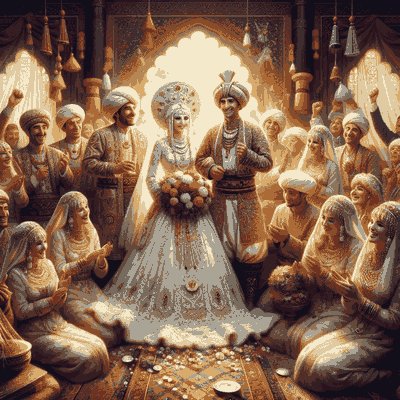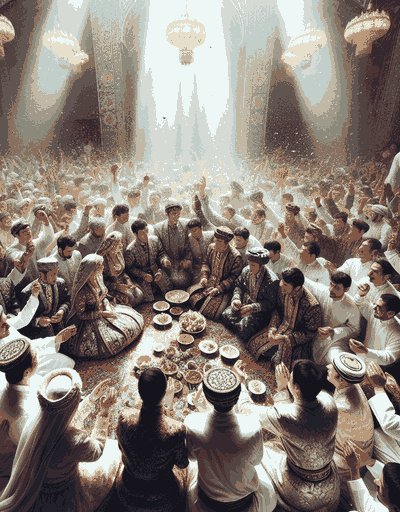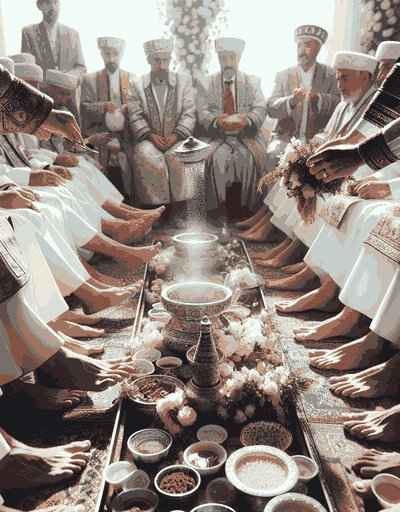Turkmenistan Wedding Traditions Complete Guide for Modern Couples
Turkmenistan wedding traditions are elaborate multi-day celebrations that blend Islamic customs with ancient Central Asian rituals, typically lasting 3-5 days and involving 200-1,000 guests. These traditions encompass matchmaking ceremonies, bride price payments averaging $10,000 USD, distinctive red wedding attire, and community-wide festivities, creating celebrations that reflect Turkmenistan’s 5.9 million population and diverse ethnic heritage.

Overview of Turkmen Wedding Process

- Pre-wedding phase: 3-12 months of matchmaking and negotiations
- Kalymkah-LIMbride price: $5,000-$10,000 USD payment
- Wedding duration: 3-5 days of celebrations
- Guest count: 200-1,000 attendees
- Traditional attire: Red silk dress with 5-25kg silver jewelry
- Key ceremonies: Gudachylykgoo-dah-CHIH-lik, Toytoy, Bashsalmabash-SAHL-mah, Kaitarmakai-TAR-mah
Pre-Wedding Traditions and Ceremonies

What is Gudachylyk (Turkmen Matchmaking)?
Gudachylykgoo-dah-CHIH-lik is the traditional Turkmen matchmaking process that initiates marriage negotiations between families, involving discreet community investigations and formal family meetings over 3-6 months. This centuries-old practice ensures family approval and community support for the match.
Key components of Gudachylyk:
- Neighbor investigations about prospective bride
- Formal family meetings between households
- Exchange of gifts worth $500-$2,000 USD
- Final consent from both young people
- 90% of rural marriages still use matchmaking
In modern Turkmenistan, while arranged marriages remain common in rural areas (affecting 60% of the population), urban couples in Ashgabat have more freedom in partner selection, though parental approval remains crucial.
Kalym: The Turkmen Bride Price Tradition
Kalymkah-LIM is a substantial monetary payment made by the groom’s family to the bride’s family, ranging from $5,000-$10,000 USD in contemporary Turkmenistan. This ancient tradition demonstrates the groom’s financial capability and commitment to the marriage.
Current kalym practices in 2025:
- Average payment: $7,500 USD (250,000 manatmah-NAHT)
- University-educated brides: Up to $10,000 USD
- Public sector employees: 20% higher prices
- Carpet weavers: Premium 15-25% added
- Payment timeline: 6-12 months installments
- Prevalence: 9 out of 10 marriages involve kalym
The Soviet-era ban on kalym has been completely reversed since independence in 1991, with the practice flourishing across all socioeconomic levels.
Gelin-Geim: Wedding Gift Exchange Traditions
Gelin-Geimgeh-LIN gay-EEM refers to the elaborate gift exchange between families following engagement, valued at $2,000-$5,000 USD total. This tradition strengthens bonds between families while providing the bride with essential items for married life.
Traditional gift categories:
- For the bride: Gold jewelry (minimum 50 grams), seasonal clothing sets, 10-20 fabric cuts
- Atgulakaht-goo-LAHK tradition: Gifts for bride’s mother and female relatives
- Return gifts: Equal-value bundles in decorated scarves
- Timing: Distributed 1-2 days before wedding
- Modern additions: Electronics and household appliances
Turkmen Bridal Dowry Preparation
The bridal dowry (çyýezchih-YEZ) is a collection of handmade carpets, household items, and textiles prepared by the bride with family assistance, valued at $3,000-$8,000 USD. This tradition showcases the bride’s skills and her family’s prosperity.
Dowry components in order of importance:
- Handwoven carpets: 2-5 pieces ($1,000-$3,000 each)
- Chuvalchoo-VAHL bags: 10-15 stripe-woven storage bags
- Kitchenware: Complete sets for 50+ guests
- Embroidered textiles: 20-30 pieces
- Modern appliances: Added in urban areas
The dowry is formally transported to the groom’s house exactly 9 days before the wedding in a ceremonial procession.
Wedding Attire and Symbolic Elements

The Turkmen Red Wedding Dress Tradition
The traditional Turkmen bridal dress is a scarlet red silk garment adorned with massive silver decorations weighing 5-25 kilograms, symbolizing fertility, protection, and prosperity. This distinctive attire has been worn by Turkmen brides for over 500 years.
Components of traditional bridal attire:
- Ketenikeh-TEH-nee dress: Red silk fabric costing $300-$500
- Gelin kurtekoor-TEH: Embroidered scarlet robe ($500-$1,000)
- Silver jewelry: 5-25kg including bracelets, necklaces, headpieces
- Protective amulets: Triangular pouches with coal and salt
- Camel wool threads: Woven into dress hem
- Modern adaptations: Lighter copper jewelry or rentals ($200-$300/day)
The red color is believed to protect against the “evil eye” by attracting and deflecting negative energy away from the bride.
Bashsalma: The Headdress Changing Ceremony
Bashsalmabash-SAHL-mah is the ceremonial changing of the maiden’s headdress (takhyatahk-YAH) to a married woman’s large colorful scarf, marking the bride’s transition to married status. This ritual occurs after the main wedding feast at the groom’s house.
Ceremonial process:
- Circle formation: Bride’s friends form protective circle
- Symbolic struggle: Married women “overcome” the maidens
- Headdress exchange: Small takhya replaced with large scarf
- Preservation: Maiden scarf saved for next generation
- Duration: 15-30 minute ceremony
This tradition continues in 85% of traditional Turkmen weddings, particularly in rural communities.
Protective Wedding Amulets and Charms
Turkmen brides wear multiple protective amulets believed to guard against evil spirits and ensure prosperity, a practice combining pre-Islamic shamanic beliefs with Islamic traditions. These items are sewn into the wedding dress or worn as jewelry.
Types of protective elements:
- Triangle pouches: Containing coal, salt, and herbs
- Silver plates: Engraved with protective verses
- Eye beads: Blue glass to deflect evil eye
- Camel wool: Natural fiber for strength
- Written prayers: Folded inside fabric pouches
- Modern practice: 70% of brides include some amulets
Wedding Ceremony Traditions
What is a Turkmen Toy (Wedding Celebration)?
Toytoy is the main Turkmen wedding celebration lasting 3-5 days with 200-1,000 guests, featuring elaborate feasts, traditional music, and ceremonial rituals. This community-wide event demonstrates family prosperity and maintains social bonds.
Toy celebration timeline:
- Day 1: Ceremonies at bride’s home (200-300 guests)
- Day 2: Main celebration at wedding venue (500-1,000 guests)
- Day 3: Family gatherings and gift exchanges
- Days 4-5: Extended celebrations for close relatives
- Daily costs: $5,000-$15,000 USD per day
- Total budget: $25,000-$50,000 USD average
Modern celebrations at Ashgabat’s Bagt Koshgibahgt KOSH-gee Wedding Palace can accommodate up to 1,000 guests in the Ak Ýolahk yol banquet hall.
The Turkmen Wedding Procession
The wedding procession (Kejebekeh-JEH-beh) is the ceremonial transport of the bride from her family home to the groom’s residence, historically using decorated camels but now featuring elaborately adorned car motorcades. This journey symbolizes the bride’s life transition.
Traditional vs. modern processions:
- Historical: Camel caravans with bells and carpets
- Contemporary: 10-20 car motorcades
- Decorations: Special scarves instead of ribbons
- Stops: 3-5 ceremonial halts for gift-giving
- Gifts distributed: Woven scarves worth $20-$50 each
- Duration: 1-2 hours depending on distance
Gushak Chesdi: The Belt Untying Ceremony
Gushak Chesdigoo-SHAHK ches-DEE is a playful wedding ritual where the bride must untie the groom’s sand-filled belt scarf and remove his traditional garments while friends create humorous obstacles. This tradition tests the bride’s determination and creates community merriment.
Ceremony components:
- Challenge items: Belt, boots, hat, gown
- Difficulty level: Belt filled with 5-10kg sand
- Participants: 10-15 friends from each side
- Duration: 20-30 minutes
- Success rate: Bride always wins with help
- Modern practice: Performed in 60% of traditional weddings
Post-Wedding Traditions
Kaitarma: The Bride’s Return Visit
Kaitarmakai-TAR-mah is the traditional return visit of the new bride to her parents’ home before final kalymkah-LIM payment completion, lasting 3-7 days. This transition period maintains family connections while formalizing the marriage.
Kaitarma celebration details:
- Timing: 1-2 weeks after wedding
- Duration: 3-7 days at parents’ home
- Special attire: Red pin-striped gown ($200-$300)
- Return outfit: Dark green-olive cape
- Feast costs: $1,000-$2,000 USD
- Participants: 50-100 close relatives
First Month Marriage Restrictions
Traditional Turkmen beliefs prescribe specific behavioral restrictions for new brides during their first 40 days of marriage, aimed at protecting them from negative influences during this vulnerable transition period.
Traditional restrictions include:
- No walking on animal blood spots
- Avoiding dirty water or cinder
- Not passing under certain trees
- No funeral or commemoration attendance
- Right foot first when entering new home
- Limited contact with birth family
Modern urban couples observe these restrictions selectively, with rural communities maintaining stricter adherence (70% vs. 30% compliance rates).
The Otko Kirgizuu Visit
Otko kirgizuuOT-koh kir-gih-ZOO is the formal visit that grants the new bride permission to freely visit her parents after marriage, typically occurring 2-3 months after the wedding. This ceremony marks her full integration into the husband’s family.
Visit requirements:
- Participants: Bride, husband, and his relatives
- Gifts brought: $500-$1,000 value
- Duration: Full day celebration
- Feast provision: By bride’s parents
- Modern practice: Simplified in urban areas
- Rural adherence: 80% still observe
Music, Dance, and Celebration Elements
Traditional Turkmen Wedding Music
Turkmen wedding music features region-specific songs performed by female musicians with tambourine accompaniment, with government regulations now requiring 70% Turkmen music content at wedding celebrations. These songs vary across Turkmenistan’s five provinces.
Musical elements by region:
- Mary Province: “Ýar-ýaryar-yar” wedding songs
- Lebap Province: “Öýlen-öýlenoy-LEN oy-LEN” melodies
- Dashoguz Province: “Toý aýdymytoy ai-DIH-mih” traditions
- Balkan Province: Coastal-influenced rhythms
- Ahal Province: Capital region fusion styles
Traditional Wedding Dances
Turkmen wedding dances include Kushdeptikoosh-DEP-tee, Chapakchah-PAHK, and LezgiLEZ-gee performed throughout the celebration, with guests distributing gifts during performances. These dances maintain cultural connections across generations.
Popular wedding dances:
- Kushdepti: National couple’s dance (90% of weddings)
- Chapak: Energetic group dance
- Sallanma gozelsahl-LAHN-mah goh-ZEL: Women’s graceful dance
- Hekjebekushhek-jeh-beh-KOOSH: Regional circle dance
- Lezgi: Fast-paced Caucasian-influenced dance
- Gift distribution: $5-$20 items during dances
Turkmen Wedding Feast Traditions
Traditional wedding feasts feature ceremonial dishes costing $30-$50 per guest, with meals concluding before midnight and newlyweds departing early. The menu reflects centuries of culinary tradition.
Essential ceremonial dishes:
- Katıklaşkah-tihk-LAHSH: Simmered meat with rice ($15/serving)
- Çektirmechek-TEER-meh: Special guest pilaf ($20/serving)
- Kurmakoor-MAH: Cubed meat in fat ($25/serving)
- Toy nanıtoy nah-NIH: Ceremonial wedding bread
- Modern additions: International cuisine options
- Average cost: $10,000-$15,000 per feast day
Regional Variations in Turkmen Weddings
Urban vs. Rural Wedding Differences
Urban Turkmen weddings in Ashgabat incorporate modern elements while maintaining core traditions, contrasting with rural celebrations that preserve historical practices more strictly. This divide reflects Turkmenistan’s 52% urban, 48% rural population split.
Key differences by location:
Urban weddings (Ashgabat, Turkmenbashi):
- Venue preference: Wedding palaces (70%)
- Guest count: 300-500 average
- Modern music: 30% non-traditional
- Simplified rituals: 50% of traditions
- Photography: Professional packages ($1,000-$2,000)
Rural weddings (village settings):
- Venue: Family compounds (85%)
- Guest count: 500-1,000 average
- Traditional music: 95% compliance
- Full rituals: 85% of traditions observed
- Documentation: Amateur photography
Provincial Wedding Variations
Each of Turkmenistan’s five provinces maintains distinct wedding customs influenced by historical tribal affiliations and geographic factors. These variations make each region’s celebrations unique.
Regional distinctions:
- Ahal Province: Most elaborate silver jewelry (10-25kg)
- Mary Province: Longest celebrations (5-7 days)
- Lebap Province: Largest kalymkah-LIM payments ($8,000-$12,000)
- Dashoguz Province: Biggest guest counts (800-1,200)
- Balkan Province: Unique coastal ceremony elements
Modern Adaptations and 2025 Trends
Contemporary Wedding Venues
The Bagt Koshgibahgt KOSH-gee Wedding Palace in Ashgabat serves as Turkmenistan’s premier wedding venue, hosting 40% of capital city marriages with its 1,000-guest capacity and traditional-modern architectural fusion. Built in 2011, it symbolizes national marriage values.
Modern venue features:
- Capacity: 1,000 guests in main hall
- Smaller halls: 200-500 guest options
- Cost: $5,000-$10,000 per event
- Amenities: Professional catering, AV systems
- Booking: 6-12 months advance required
- Presidential portraits: Mandatory photo locations
Digital Integration in Turkmen Weddings
Professional photography and social media documentation have become essential elements of modern Turkmen weddings, with couples investing $1,000-$3,000 in digital memories. This represents a significant shift from traditional documentation methods.
Digital wedding services:
- Photography packages: $800-$2,000
- Videography: $500-$1,500
- Drone coverage: $300-$500
- Social media management: Increasing trend
- Digital invitations: 30% adoption rate
- Live streaming: For diaspora family members
Economic Considerations and Adaptations
Rising wedding costs averaging $30,000-$50,000 have led 40% of Turkmen families to adapt traditions through payment plans, shared celebrations, or simplified ceremonies while maintaining symbolic importance.
Cost-saving adaptations:
- Jewelry rentals: $200-$300/day vs. $5,000 purchase
- Shared venues: 2-3 weddings per day
- Reduced guest lists: 200-300 vs. traditional 500+
- Simplified dowries: Focus on essential items
- Payment plans: 12-24 months for kalymkah-LIM
- Government assistance: Some provinces offer wedding loans
This comprehensive guide represents Turkmenistan’s living wedding traditions that continue evolving while honoring centuries of [cultural heritage](https://www.si.edu/learn. From the matchmaking process of Gudachylykgoo-dah-CHIH-lik to the elaborate Toytoy celebrations, these customs reflect the central importance of family, community, and cultural identity in Turkmen society.
Frequently Asked Questions
How long does a traditional Turkmenistan wedding celebration last?
Traditional Turkmenistan weddings typically last 3-5 days, with various ceremonies and celebrations occurring throughout this period.
What is the Kalym bride price in Turkmenistan?
The Kalym (bride price) typically ranges from $5,000-$10,000 USD, with an average of $7,500, paid by the groom's family to the bride's family.
Why do Turkmen brides wear red?
Red wedding dresses symbolize fertility, protection, and good fortune in Turkmen culture. The traditional dress is accompanied by 5-25kg of silver jewelry.
What is Gudachylyk in Turkmen weddings?
Gudachylyk is the traditional matchmaking process that ensures family and community approval, still practiced in 90% of rural marriages.
How many guests attend a typical Turkmen wedding?
Turkmen weddings typically host between 200-1,000 guests, demonstrating family prosperity and community connections.
What is the Bashsalma ceremony?
Bashsalma is the headdress changing ceremony marking the bride's transition to married status, practiced in 85% of traditional weddings.
How much does a traditional Turkmen wedding cost?
Including the Kalym, gifts, dowry, and celebrations, a traditional wedding can cost $15,000-$30,000 USD or more.
What is the Kaitarma tradition?
Kaitarma is the bride's return visit to her family, lasting 3-7 days, which helps maintain family connections after marriage.
Are arranged marriages common in Turkmenistan?
While arranged marriages are still common in rural areas, urban couples increasingly choose their own partners with family approval.
How do modern Turkmen weddings differ from traditional ones?
Modern weddings, especially in urban areas, blend traditional customs with contemporary elements like professional photography and modern venues.